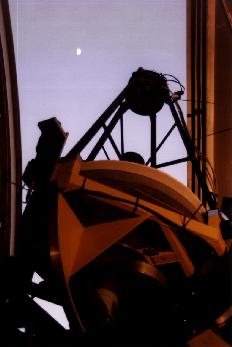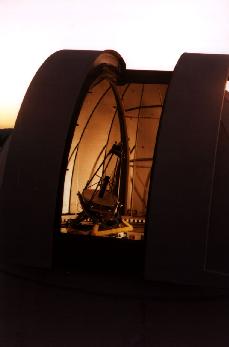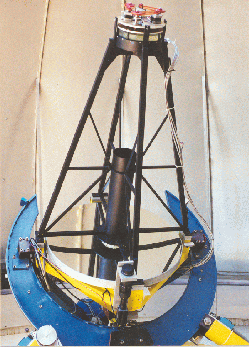The Katzman Automatic Imaging Telescope
One of the World's Most Successful Nearby Supernova Search Engine



Located at Lick Observatory atop Mount Hamilton, just east of San Jose,
California, the Katzman Automatic Imaging Telescope (KAIT) is an entirely
robotic telescope dedicated to the search for supernovae and the monitoring of
celestial objects. It is a 76 cm diameter reflecting telescope equipped with a
CCD camera and automatic guider.
The KAIT project is led by Professor Alex Filippenko of the UC Berkeley Astronomy Department. Dr. Richard Treffers (formerly of UC Berkeley) and Professor Michael Richmond (currently at the Rochester Institute of Technology) also devoted several years of effort, and Dr. Weidong Li spent 14 years running KAIT (1997-2011). Dr. WeiKang Zheng is now in charge of KAIT nightly operations, assisted by Dr. Thomas Brink. Over the years, more than 100 UC Berkeley undergraduate students have been involved with KAIT. Current undergraduate team members include Andrew Bigley, Sanyum Channa, Nick Choksi, Maxime de Kouchkovski, Goni Halevi, Andrew Halle, Sahana Kumar, Sara Lopez, Jeff Molloy, Andrew Richter, Timothy Ross, Samantha Stegman, Haynes Stephens, and Sameen Yunus.
For a description of the prototype instrument, see Richmond, Treffers, and
Filippenko (1993), Publications of the Astronomical Society of the Pacific,
105, 1164-1174. For a more recent description of KAIT and its supernova search,
see Filippenko (2001), in Small-Telescope Astronomy on Global Scales, ed.
W. P. Chen, C. Lemme, and B. Paczynski (San Francisco: Astron. Soc. Pacific,
Conf. Ser. Vol. 246), 121-130. Lists of press releases and KAIT papers are
given below.
Major funding for KAIT was provided to Filippenko by the National Science
Foundation, AutoScope Corporation, Photometrics Ltd., Sun Microsystems,
the Hewlett-Packard Company, Lick Observatory, and the University of
California. Completion of the telescope was made possible by a generous
donation from the Sylvia and Jim Katzman Foundation. Current funding for
KAIT research is provide by the Katzman Foundation, the TABASGO Foundation,
NSF, and NASA.
KAIT Highlights:
- Old KAIT news
.
- A new AP7 CCD camera is installed in KAIT. New software to control the camera
is compiled and tested. With the new camera KAIT can go as deep as just 19
magnitude in 20 second exposures. KAIT is now observing with 30 seconds (with
limiting magnitude about 19.5 mag) and has an efficiency of 70 images/hour. --08/01/98
- Dome tolerance angle is added to the observation software so it further
improves the efficiency of KAIT -- now at 80-90 images/hour. --08/26/98
- KAIT discovered a comet in the evening of the Christmas day! --12/25/98
- The four epoch color images of SN 1998dh appeared in the Dec, 1998
issue of the "Science" magzine (vol. 282, page 2156).
- "Catch as KAIT Can" -- a news note about the KAIT project appeared in
the Jan, 1999 issue of the "Sky and Telescope" magzine (page 26).
- KAIT discovered another comet! This is amazing considering the small
field of view of the KAIT camera.
- We have received a generous donation from Hewlett-Packard to help improve
the computing power of the project, which includes two HP Kayak XA-s workstations
with dual processors, CD writers, printers and DAT tape drives. Both computers
have been successfully hooked up for Linux. For the first time the image
processing is ahead of the observations!
- We are now officially collaborating with Michael Schwartz
of the Tenagra Observatories. The official name for the collaboration is
the Lick Observatory and the Tenagra Observatory Supernova Searches
(LOTOSS) . The first SN from LOTOSS, SN 2000dx, was discovered by Michael Schwartz, using
the 0.5m Tenagra III automated telescope.
- SN 2001E marks the 100th SN discovery
of KAIT. With 1 SN discovery in year 1997, 20 in year 1998, 40 in year 1999, 36 in
year 2000, and 3 so far in year 2001, the total number of KAIT SN discoveries
reaches 100 on Jan 6, 2001.
- KAIT responded to Gamma-Ray Burst (GRB) 021211 at real time, and caught
the GRB at 108 sec after the burst. Sequences of images were obtained with KAIT,
which yield the best early-time light curve ever observed for a GRB. See above
link for a press release on the KAIT observations of GRB 021211.
- KAIT observations of GRB 020813
- KAIT discovered a very young type Ia SN 2012cg, automatically triggered multi-band follow-up observations only 5 minutes after the discovery image was taken.
- KAIT discovered a very young type Ia SN 2013dy, first detection at merely ~2.4hr after the explosion (/firt light time).
- KAIT pre-discovery detection of SN 2014J in M82
- KAIT discovered a bright type Ia supernova SN 2016coj, the brightest SN of the year 2016.
- KAIT monitoring of the very young Type IIb SN 2016gkg
- Discoveries in 2019: 1 SNe (+17 independent), 0 novae (+3 independent), 3 other (+1 independent)
- Discoveries in 2018: 12 SNe (+25 independent), 2 novae (+3 independent), 3 other (+3 independent)
- Discoveries in 2017: 4 SNe (+12 independent), 3 novae (+11 independent), 3 other
- Discoveries in 2016: 10 SNe (+21 independent), 7 novae (+9 independent), 2 unknown
- Discoveries in 2015: 10 SNe (+15 independent), 2 novae (+7 independent), 2 unknown
- Discoveries in 2014: 16 SNe, 2 novae
- Discoveries in 2013: 13 SNe, 5 novae
- Discoveries in 2012: 9 SNe, 2 novae
- Discoveries in 2011: 29 SNe
- Discoveries in 2010: 51 SNe
- Discoveries in 2009: 54 SNe
- Discoveries in 2008: 77 SNe
- Discoveries in 2007: 69 SNe
- Discoveries in 2006: 84 SNe
- Discoveries in 2005: 82 SNe
- Discoveries in 2004: 83 SNe
- Discoveries in 2003: 95 SNe, 5 novae.
- Discoveries in 2002: 82 SNe, 5 novae.
- Discoveries in 2001: 68 SNe, 3 novae.
- Discoveries in 2000: 38 SNe, 2 novae
- Discoveries in 1999: 40 SNe, 7 novae, 1 CV, 1 comet
- Discoveries in 1998: 20 SNe, 4 novae, 2 CVs, 1 comet
Features:
This material is based upon work supported by the National Science Foundation
under Grant numbers AST-8957063, AST-9115174, AST-9417213, AST-9987438,
AST-0307894, AST-0607485, AST-0908886, and AST-1211916.
Any opinions, findings, and conclusions or recommendations expressed in this
material are those of the authors and do not necessarily reflect the views of
the National Science Foundation.

Return to BAIT home page
Last Updated Nov/08/2016 by Weikang Zheng


